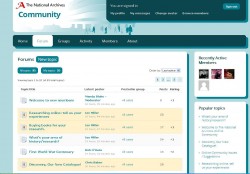My role here at The National Archives is to carry out and manage customer research and make sure that the voice of the customer is heard. When I say ‘customer research’, I don’t mean the historical research that our users explore but rather researching the needs, wants and expectations of our customers. This can involve a whole host of activities including focus groups, interviews, sitting next to someone at a computer observing how they behave and even asking people to fill out diaries of their experiences for us to look at. All of which is helps us improve the services we offer, with our users at the heart of it.

The community in action
One audience which has always been a challenge to get in depth and real time feedback from is the ‘online user’. A dauntingly large group which incorporates over 13 million people a year carrying out a huge breadth of tasks for a huge number of reasons. Some of them are regular visitors while some visit just once never to return again. With such a broad and diverse audience, how can we make sure individuals get their opinions heard and how can we get them more involved in what we do? Myself and colleague James Lawson set up a project team to find a solution.
In the current environment, we needed to be clever and economical about how we cracked this problem. We decided to trial an online community where users could create discussion topics, set up groups for like minded interests and get involved with us and each other. The aim of this community was two-fold. We wanted to be able to engage with an audience it is often difficult to hear from and, secondly, we wanted a space were we could ask people to discuss things that we were keen to get feedback on and at the same time allow them to start their own conversations.
Following the success of our Blog, Archives Media Player and Labs sites, we decided that we would use our own (fantastic) in house skills and build the platform ourselves using a WordPress tool called BuddyPress. This tool essentially provides a customisable community space including discussion forums and groups. It ticked all the boxes (and the fact that it was free was an added bonus!)
Once we had built the platform, we set about piloting a closed community to see whether there was any interest and if it would take off. That question was quickly answered: we originally set out to recruit 100 members for the community, after receiving 6,000 expressions of interest we decided to grow the closed pilot community to around 300 members over a six month period.
The pilot was deemed a success and, after nine months, the decision was made to open up the community to all our users. So, with a few updates and a redesign (based on feedback from the community), we now have a space where our online users can get involved and join in discussions with The National Archives and each other.
We currently have 530 members (and counting!), 85 discussion topics and ten groups. We are now keen to grow the community and get more people on board – it’s open to anyone whether they be professional researchers, family historians, information management professionals or members of the archives sector. Anyone with an interest is welcome to join and get involved.
We have a community team managing and moderating the community. We post topics regularly to ask people their opinions and encourage others to create their own topics and groups. We have even appointed a regular member of the community, Mandy Blake, as a moderator to help us out.
It’s been a great pleasure seeing the community grow and we’ve had some really interesting discussions so far. For us, the community is a great way to interact with our online audience and break down the barriers that sometimes exist in an online space. It’s also another way of ensuring that we keep our users at the forefront of what we do.
Personally, it’s been a real eye opener seeing what people write about how they use The National Archives and how they carry out their research, One particular conversation involved the community discussing the types of multimedia they use when researching – someone mentioned that they had started using Google Street View to identify places they are researching, something which it soon turned out a number of people had started using for the same thing. This was something that I had never heard of being used in this way but, of course, it makes complete sense! The community has got off to a great start and we hope that it continues to grow and become an integral part of our online experience.
If you would like to get involved please register for the community. Anyone is welcome to join and we would highly recommend that you get involved !
An excellent approach from the public sector aimed at the customer
Superb. Been waiting for something like this for a long time.
Stellar work